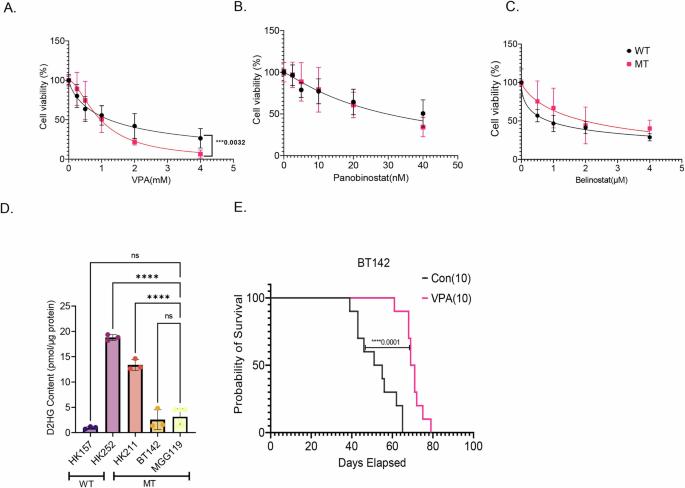Valproic acid targets IDH1 mutants through alteration of lipid metabolism
引用次数: 0
Abstract
Histone deacetylases (HDACs) have a wide range of targets and can rewire both the chromatin and lipidome of cancer cells. In this study, we show that valproic acid (VPA), a brain penetrant anti-seizure medication and histone deacetylase inhibitor, inhibits the growth of IDH1 mutant tumors in vivo and in vitro, with at least some selectivity over IDH1 wild-type tumors. Surprisingly, genes upregulated by VPA showed no enhanced chromatin accessibility at the promoter, but there was a correlation between VPA-downregulated genes and diminished promoter chromatin accessibility. VPA inhibited the transcription of lipogenic genes and these lipogenic genes showed significant decreases in promoter chromatin accessibility only in the IDH1 MT glioma cell lines tested. VPA inhibited the mTOR pathway and a key lipogenic gene, fatty acid synthase (FASN). Both VPA and a selective FASN inhibitor TVB-2640 rewired the lipidome and promoted apoptosis in an IDH1 MT but not in an IDH1 WT glioma cell line. We further find that HDACs are involved in the regulation of lipogenic genes and HDAC6 is particularly important for the regulation of FASN in IDH1 MT glioma. Finally, we show that FASN knockdown alone and VPA in combination with FASN knockdown significantly improved the survival of mice in an IDH1 MT primary orthotopic xenograft model in vivo. We conclude that targeting fatty acid metabolism through HDAC inhibition and/or FASN inhibition may be a novel therapeutic opportunity in IDH1 mutant gliomas.

丙戊酸通过改变脂质代谢靶向 IDH1 突变体
组蛋白去乙酰化酶(HDAC)具有广泛的靶点,可以重新连接癌细胞的染色质和脂质体。在这项研究中,我们发现丙戊酸(VPA)是一种脑渗透性抗癫痫药物和组蛋白去乙酰化酶抑制剂,它能抑制体内和体外 IDH1 突变肿瘤的生长,至少对 IDH1 野生型肿瘤有一定的选择性。令人惊讶的是,VPA 上调的基因没有显示出启动子染色质可及性的增强,但 VPA 下调的基因与启动子染色质可及性的减弱存在相关性。VPA 抑制了致脂基因的转录,只有在检测的 IDH1 MT 胶质瘤细胞系中,这些致脂基因的启动子染色质可及性才会显著降低。VPA 抑制了 mTOR 通路和一个关键的致脂基因--脂肪酸合成酶(FASN)。VPA 和选择性 FASN 抑制剂 TVB-2640 都能重新连接脂质体,促进 IDH1 MT 胶质瘤细胞系的细胞凋亡,但不能促进 IDH1 WT 胶质瘤细胞系的细胞凋亡。我们进一步发现,HDACs 参与了生脂基因的调控,而 HDAC6 对 IDH1 MT 胶质瘤中 FASN 的调控尤为重要。最后,我们发现单独敲除 FASN 和 VPA 联合敲除 FASN 能显著提高 IDH1 MT 原发性异位移植模型小鼠的存活率。我们的结论是,通过 HDAC 抑制和/或 FASN 抑制来靶向脂肪酸代谢可能是 IDH1 突变胶质瘤的一个新的治疗机会。
本文章由计算机程序翻译,如有差异,请以英文原文为准。
求助全文
约1分钟内获得全文
求助全文

 求助内容:
求助内容: 应助结果提醒方式:
应助结果提醒方式:


